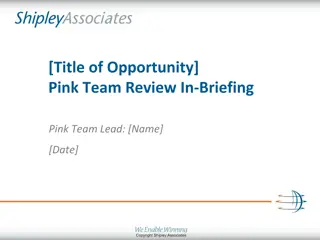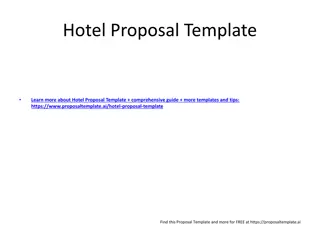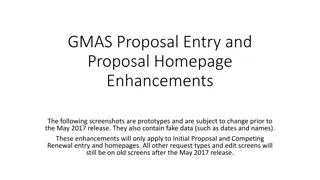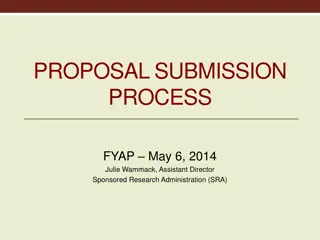Effective Proposal Writing for Health Research
Learn about the fundamentals of research proposals for health-related studies, including defining research, understanding the purposes of health research, and exploring motivation for undertaking research. Discover the difference between basic and applied research, examine types of research, and delve into the significance of research in contributing innovative solutions to health challenges.
Download Presentation

Please find below an Image/Link to download the presentation.
The content on the website is provided AS IS for your information and personal use only. It may not be sold, licensed, or shared on other websites without obtaining consent from the author. Download presentation by click this link. If you encounter any issues during the download, it is possible that the publisher has removed the file from their server.
E N D
Presentation Transcript
PROPOSAL WRITING FOR HEALTH AND HEALTH- RELATED RESEARCH Assefa Seme
Learning Objectives At the end of the session, participants should be able to Define the term research and describe the difference between basic and applied researches Describe the major characteristic of research Describe the two major purposes of health research Describe what a research proposal is
What is research? Search for knowledge An art of scientific investigation Dictionary meaning Careful investigation or inquiry specially through search for a new facts in any branch of knowledge Movement from known to the unknown. It is a voyage of discovery.
What is research? Research is the systematic collection, analysis and interpretation of data to answer a certain question or solve a problem. Health research is a research effort to address health related problems and come up with better solutions to mitigate the prevailing problem
What makes people to undertake research?
Motivation in Research Desire to get a research degree along with its consequential benefits Desire to face the challenge in solving the unsolved problems, i.e. concern over practical problems initiates research Desire to get intellectual joy of doing some creative work Desire to be of service to society Desire to get respectability
Motivation in Research Directives of government Employment condition Curiosity about new things Desire to understand causal relationship Social thinking and awakening
Basic versus applied research Basic research- fundamental, pure Is designed to extend the bases of knowledge in a discipline, for the sake of understanding itself Gathering knowledge for knowledge s sake Purpose: is necessary to generate new knowledge and technologies to deal with major unresolved health problems Concerned with formulation of theory Ultimately some of this knowledge may be applied
Basic versus applied research Applied research action research is problem oriented & directed towards the solution of an existing problem concentrates on finding solutions to immediate problems of practical nature Purpose: is necessary to identify priority problems and to design & evaluate policies and programs that will deliver the greatest health benefits, making optimal use of available resources.
Empirical research The philosophical approach to research is basically of two types: Empirical and theoretical. Health research mainly follows the empirical approach, i.e. it is based upon observation & experience more than upon theory & abstraction. Empirical research in the health sciences can be qualitative or quantitative in nature. In most cases, health science research deals with information of a quantitative nature i.e. measurement of quantity or amount.
Empirical research Qualitative research is a type of formative research that offers specialized techniques for obtaining in-depth responses about what people think and how they feel. It enables program management to gain insight into attitudes, beliefs, motives and behaviors of the target population. It deals with the emotional and contextual aspects of human response rather than with objective measurable behaviors and attitudes.
Characteristics of research It demands a clear statement of the problem It requires a clear objective and a plan (it is not aimlessly looking for something in the hope that you will come across a solution). It builds on existing data, using both positive and negative findings New data are systematically collected and analyzed to answer the original research objectives.
Research proposal What is a research proposal? Is a document that presents a plan for a project to reviewers for evaluation. It can be a supervised project submitted to instructors as part of educational degrees (masters thesis, PhD dissertation) Can be a project proposed to funding agency Purpose of a research proposal Convince reviewers that the researcher is capable of successfully conducting the proposed research project. Provide clear indication of the topic in which the researcher is interested Give indication of researcher's ability to develop an interesting research question
Research proposal Reviewers have more confidence that planned projects will be successfully completed , if proposal is well written, organized and demonstrate careful planning Is considered as preliminary indicators of the researcher s area of interest and potentials to undertake the research work without problem. Will be considered in conjunction with researcher s academic qualifications and previous exposures in undertaking similar research work Researcher s qualification provide evidence about his/her academic ability to undertake proposed research work
Research proposal The proposal is similar to a research report, but written before the research project begins Research proposal Describes research problems and its importance Gives details of the methods that will be used and why they are appropriate Has plan for data collection and analysis Includes schedules of the steps to be undertaken and estimates of the time and budget required to carry out each step of the research
Content of research proposal The proposal for quantitative research has most important parts of the research report: A title An abstract Introduction: problem statement, rationale A literature review Research objective A method or design section A bibliography It lacks result, discussion, and conclusion
Research proposal Research proposal is not only judged by its content, but also by its form Must look professional Must be typed and written in good English Should be well structured with section headings clearly indicated If photocopy, it has to be of high quality Always include bibliography/references
Changes to research proposal It is natural for ideas to evolve and change You will not forced to adhere to specifics of your proposal Avoid making any substantial changes to the broad direction of your proposal after acceptance by your donor, supervisors or organizations Proposal is the basis of your working relationship with your supervisors and potential donors and thus it cannot be radically altered without discussion and consultation with your supervisors or donors.
Learning Objective Describe the reasons for including a statement of the problem in a research proposal Describe what a research problem is Outline information that should be included in the statement of the problem Prepare the statement of the problem for the research proposal being developed during the course.
Formulating problem statement and justification of the problems The first major section in a research proposal is the statement of the problem It should describe the problem that is to be investigated and the question that will guide the research process All research is set in motion by the existence of a problem
What is a research problem? A problem is a perceived discrepancy between what some one believes should the situation be and what the situation is in reality While problems are initiating force behind research, not all problems require research
What is a research problem? A potential research situation arises when three conditions exist A perceived discrepancy exists between what is & what should be. A question exists about why there is a discrepancy At least two possible & plausible answers exist to the question
Why is it important to state & define the problem? Because a clear statement of the problem : Is the foundation for further development of the research proposal (objectives, methodology, work plan, budget, etc) Makes it easier to find information & reports of similar studies from which your own study design can benefit. Enables you to systematically point out why the proposed research on the problem should be undertaken & what you hope to achieve with the study results.
Information to be included in problem statement? Context in which the problem occurs : A brief description of socio-economic & cultural characteristics; overview of health status & health-care system; relevant statistics. Nature of the problem (the discrepancy b/n what is & what should be) & size, distribution & severity of the problem (who is affected, where, since when, & what are the consequences for those affected & for the services). For a descriptive or evaluation study the different components of the problem should be elaborated.
Information to be included in problem statement? An analysis of the major factors that may influence the problem & a discussion of why certain factors need more investigation if the problem is to be fully understood. Justification for the study: A brief description of any solutions to the problem that have been tried in the past, how well they have worked, and why further research is needed. A description of the type of information expected to result from the project and how this information will be used to help solve the problem.
Tips on how to write a problem statement? It should be precise & concise, while not forgetting to mention essential points. Information concerning the problem should be summarized, & brief so the reader is not drowned in detail. An outline listing the major points to be covered could be prepared before any writing is done, so the section will be logical and well organized.
Example: Statement of the problem Factors Contributing to Unattended Delivery among ANC Attendants at Government-owned Health Centers in Addis Ababa. Addis Ababa is the capital city of Ethiopia with an area of 530 km2 and a total population of 3 Million. It has 10 sub-cities. The health service coverage of Addis Ababa is 71%. There are 5 hospital, 24 health centers, 32 health posts & more than 500 private health institutions providing health services including ANC and Delivery. ANC coverage of the city is estimated at 86%. Despite this high coverage of ANC only 56% of pregnant women give birth in health institutions, while the remaining 44% deliver elsewhere, including unattended home deliveries. Unattended deliveries are known to be associated with maternal and perinatal morbidity and mortality, such as antepartum hemorrhage (APH), postpartum hemorrhage (PPH), birth trauma, infection, and fistula. There are no studies that have examined the factors contributing to unattended delivery despite high overall service coverage and antenatal care coverage in Addis Ababa. Many health institutions attempt to improve the situation through the training of traditional birth attendants, expanding health education and community mobilization activities. However, these efforts are not based on systematic evidence into possible determinants of the prevailing practice. The present study is intended to contribute to bridging the information gap, and subsequently the coverage of institutional deliveries in the city.
Why literature review? Comprehensive and focused literature review on your particular topic is needed To define the set (or sub-set) of knowledge to which your research relates to most directly To learn the major 'trends' or issues in that body of knowledge that have been most significant in shaping your study To learn the theoretical agenda of that body of knowledge to which your project relate to most directly To identify the major controversies that are important for your project
Why literature review? Helps further understanding of the problem you plan to research, & may lead to refining of the Statement of the problem . Helps you find out what others have learned & reported on your topic, & take account of this in the design of your study. It gives you a familiarity with the various types of methodologies that might be used in your study. It prevents you from reinventing the wheel . Properly reviewed literature lay foundation for the study from which the rationale for the study, the statement of the problem, hypotheses or research questions, & the design of the research emerge or concretize
Why literature review? A long but complete and thoughtful review will help you convey the message, while skimpy review may depict you as unprepared for, and/or not seriously committed to the research process However, the mere length of a review without relevance can bury the essence of the research proposal itself. Hence, the literature review is the intellectual ancestor of the research project.
Literature review The result of LR should be A reaffirmation of the importance of the theoretical rationale of the project in the light of the work of others in the same area, An emphasis on the contribution which the project is likely to make to the ongoing task of building & improving theory in a given area of knowledge. The latter should be your target!
Sources for Literature review Sources for LR include Card catalogues of books in libraries Indexes such as INDEX MEDICUS, INTERNATIONAL NURSING INDEX etc. that identify journal Summaries of abstracts of books and articles Computer-based literature searches such as MEDLINE, PUBMED. Bibliographies such as those found at the end of the books, articles. Books, articles, newspapers, reports, etc. Statistics collected at the national, provincial, departmental levels. Studies conducted in the country or region. Responses to enquiries on ongoing research. Theoretical works related to the topic. Works on methodology & descriptions of methodologies of studies Opinions, beliefs, points-of-view. Anecdote, clinical observations, reports of incidents, etc.
Method of citation For an article the following information should be noted: Author (s) Surname followed by initials. Title of article. Name of Journal. Year, Volume, (number): page numbers of article. Example: Louria DB. Emerging- and re-emerging infections: The societal variables. International Journal of Infectious Disease. 1996, 1(2):59-62. For a book the following information should be noted: Author (s) Surname followed by initials. Title of book. Place: publisher, Year, Edition Example: Abramson JH. Survey methods in community medicine. Edinburgh: Churchill Livingstone, 1990, 4th ed For a chapter in a book, the reference can include: Author (s) of chapter (Surname (s) followed by initials). Chapter title. In: Editor (s) of book, (Surname (s) followed by initials). (eds). Title of book. Place: Publisher, Year: Page numbers of chapter.
Formulation of a Research Objective
Research objectives What is a research objective? It is a statement that clearly depicts the goal to be achieved by a research project. or In other words, the objectives of a research project summarize what is to be achieved by the study
Why should research objectives be formulated? The formulation of the objectives will help you Focus the study (narrowing it down to essentials); Avoid the collection of data which are not necessary for understanding & solving the problem identified (to establish the limits of the study); Organize the study in clearly defined parts or phases. Facilitate the development of research methodology Orient the collection, analysis, interpretation & utilization of data.
Research objectives When should the research objectives be prepared? After the statement of the problem & before the methodology
Research objectives What are the characteristics of good objectives? Logical & coherent Feasible Considering local conditions Defined in operational terms that can be measured Phrased to clearly meet the purpose of the study
Is this objective a SMART? Increase contraceptive prevalence by 15% in women 30-49 years of age Specific: Yes, the intended outcome of the program is specified. Measurable: Yes, contraceptive prevalence is measurable. Appropriate: Unknown, because the program s goal would need to be provided in order to know whether the objective relates logically to it. Realistic: Unknown, because the resources available to the program would need to be known. Time bound: No, the time within which the objective is to be achieved is not specified. So this objective is not known to be SMART because, although it meets some of the criteria, it does not meet them all.
How should objectives be stated? Objectives should be stated using action verbs that are specific enough to be measured Example: To determine ., To compare .. To verify .., To calculate To describe .., to assess etc Do not use vague non-action verbs To appreciate To understand , to believe .
What formats can be used for stating research objectives? Depends on the type of study that will be undertaken. If the study is descriptive or exploratory in nature, objectives are stated in the form of questions or positive sentences. Questions: The objectives of this study are to answer the following questions Positive sentence: The objectives of this study are to determine If the researcher knows enough to make predictions concerning what s/he is studying, then hypotheses may be proposed:- The objective of this study is to verify the following hypothesis... .
Types of research objectives Commonly, research objectives are classified into general objectives and specific objectives. They are logically connected to each other General objectives closely related to the statement of the problem Some times called purpose of the research Identifies in general terms what is to be accomplished by the research and why
Types of research objectives Specific objectives considered as smaller portions of the general objectives. identify in greater detail the specific aims of the research project, identify the questions that the researcher wants to answer Systematically address the various aspects of the problem as defined under Statement of the Problem & the key factors that are assumed to influence or cause the problem. They specify what to do in a study, where & for what purpose.
Example 1:A study to assess the Accessibility & Acceptability of the VCT & community perception towards HIV/AIDS C&S in X Regional State General Objective: To identify factors that affect the acceptability of VCT services & to assess perception of the community towards a comprehensive care & support activity for HIV/AIDS. Specific Objectives: To assess the KAP of the community towards HIV/AIDS & the VCT service To identify barriers & concerns related to VCT & its use To assess awareness & perception of the study community regarding comprehensive care & support activities to PLWHA Based on the study findings to forward practicable recommendations for policy makers and service providers.
Example 2: A study looking into factors influencing utilization of maternal health care services in X District General objective To assess factors influencing utilization of maternal healthcare services in District X. Specific Objectives To assess the KAP of pregnant women regarding antenatal care, and TT vaccination, To identify factors that influence women s attendance at antenatal care (ANC) & institutional delivery care services, To identify the sources of delivery service & mothers preference of place of delivery, To determine coverage with ANC & TT vaccination among mothers
























